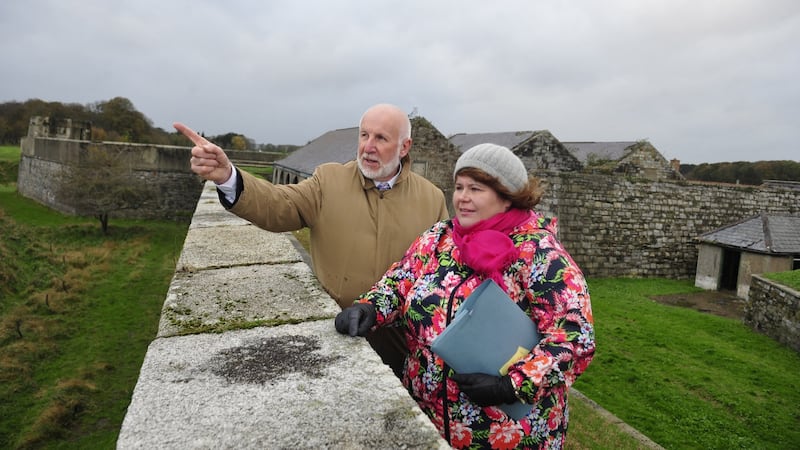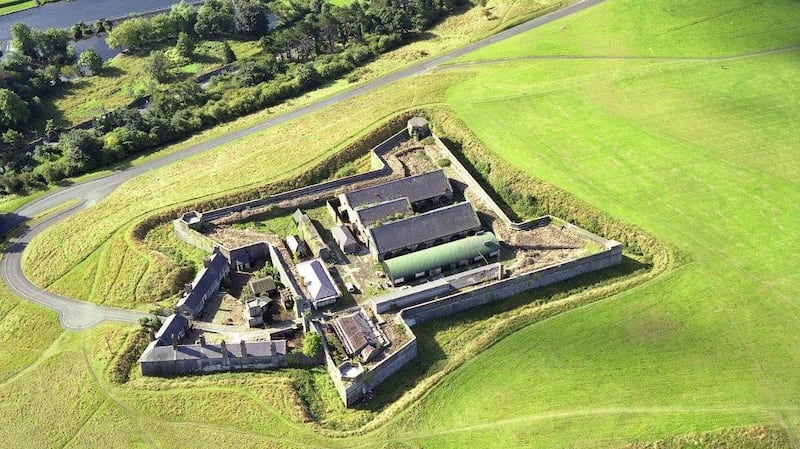The Magazine Fort, formerly the Royal Magazine Fort, is a historic ammunitions storage depot, built in 1735. It is strategically located on St Thomas’s Hill to the south-east of Phoenix Park.
Originally in a star shape, like the larger Charles Fort in Kinsale, Co Cork, it was extended to include an outer courtyard for guard houses and other residential buildings in 1801.
This outer courtyard was designed by Irish architect Francis Johnston. The Magazine Fort, which is a protected structure, is of specific interest now because of the military raids at Easter 1916. These unsuccessful raids were intended to blow up the fort as a signal for the 1916 Rising.


There was a second raid at Christmas 1939 when the Irish Republican Army stole a large consignment of guns and ammunition (on January 1st, 1940, it was reported that three quarters of these munitions – 850,000 rounds – had been recovered).
The fort was originally owned by the British Army, then the Irish Army and was handed over to the Office of Public Works (OPW) in 1988. It was built on the site of Phoenix House, a lodge built for Sir Edward Fisher, which became the principal residence of the viceroys of Ireland until 1665.
What state of dereliction is it in? The original arched gateway, inscribed with the year 1736, is in pieces in one of the storage sheds. Only the piers remain standing.
The two original magazines – with a smaller magazine added in 1758 – are intact with original barrel-vaulted ceilings, raised wooden floors and hoists for bringing the gun powder barrels inside.
The blast wall built in front of the three magazine buildings to prevent extensive damage to outlying buildings in the event of an accidental explosion, is still in place. The slate roofs are in a poor condition on many of the buildings as the lead has been stolen from them.
“The roofs of the magazine forts were re-slated and re-leaded but all the lead was stolen and some of the buildings were set on fire,” says John McMahon, OPW commissioner.
Margaret Gormley, chief park superintendant of Phoenix Park, says that the fort is inspected every day and every night. There is also CCTV but it is still vandalised.
“It’s in an isolated part of the park so anytime the gardaí arrive, there’s nobody here,” she says.
The boundary walls, ramparts and watchtowers are crumbling in parts with extensive damage to stone and bricks in some sections due to plant growth and subsequent decay.
What repairs have been carried out? Vegetation has been removed from the exterior of the boundary walls. Repair work is being done on the boundary walls, ramparts and hexagonal watchtowers inside the fort.
Conservation architect with the OPW, John Cahill, says the work involves removal, repair and re-fitting of brick and stone on the four corners of the original ramparts.
This work will give safe access to the corner bastions and ramparts along some of the boundary walls. The residential buildings in the outer courtyard have been covered with galvanised roofs to protect the interiors with the view to possible future use as a visitor centre.
Who is championing its cause? The Office of Public Works and specifically the Gormley who is aware that it's the last building in Phoenix Park to get attention.
“Our job has been to prevent further dereliction. We haven’t a plan for its future use and we are aware that this would require large investment. In fact, we are open to ideas from the public about what a future use might be,” says McMahon.
What happens next? The OPW plans to open the Magazine Fort to guided tours for small groups in 1916. Tickets are available at Phoenix Park Visitor Centre, from where the tour groups will depart. "People will be interested to see the stunning views from the ramparts, see the magazines themselves and find out more about the raids at Easter 1916," says McMahon.
“For example, one of the first fatalities of the Easter Rising arose on foot of the attempts to raid the fort. One of the volunteers followed a member of the Playfair family who lived in the Magazine Fort as he escaped. He was killed in Islandbridge.”
Longer term, the OPW plans to link visits to the Magazine Fort to other military sites in the area: the War Memorial Gardens across the Liffey and Grangegorman military cemetery.
“We would like to open up a cycling and walking trail through a military quarter, linking up all these sites and possibly building a new bridge over the Liffey in memory of the proposed Lutyens Bridge which was never built,” says Gormley.
If you have a suggested use for the Magazine Fort please contact the OPW by email at colette.davis@opw.ie
Can you help? If you have information about an important building that has fallen into disrepair please email buildingsatrisk@irishtimes.com










